The history of Mestlin
After the Second World War, the reconstruction of Mestlin to a socialist
model village begins. After the coming down of the wall, however, Mestlin shares the fate of many villages in Mecklenburg. Difficulties of a whole new
kind have to be overcome.
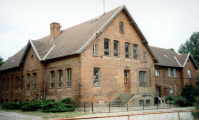 1945
Because of the immigration wave after World War II, the population of Mestlin doubles. The housing of the settlers from East-Prussia, Schlesia and
Pommerania takes place in the estate houses of Mestlin (picture on the right) and Vimfow, in the schools, in the parish and in many attics. 1945
Because of the immigration wave after World War II, the population of Mestlin doubles. The housing of the settlers from East-Prussia, Schlesia and
Pommerania takes place in the estate houses of Mestlin (picture on the right) and Vimfow, in the schools, in the parish and in many attics.
Mestlin is sad to look at at the end of the World War: the water supply comes from five pumps, electric light was only available in the estate house -
in the cottages one used train-oil-lights, the village streets are unsurfaced.
The former lease-holder Berckemeyer has left the village.
In the forestry, there were sovjet troups stationed, that should run the estate.
- 1945
- Forming of the country Mecklenburg-Vorpommern
1945; The sovjet army takes over the running of the estate, in correspondence with the instruction of the
country-administration from September 26th, 1945, dealing with the preservation of estates as large concerns.
- September 5th, 1945
- Decree on the land reform in the country Mecklenburg-Vorpommern
1945, Realization of the land reform in Kadow (28 new settlers) and Büthberg (27 new settlers)
October 1945, The classes at the two one-room-schools are being taken up again. For almost 150 students,
there are two teachers.
- 1946
- Mecklenburg has 2.139.000 inhabitants
Summer of 1946; the country's estate is being given to the country-administration of Mecklenburg and the Red
Army leaves
In the process of democratization, one administrator and one inspector are being appointed in Mestlin.
With instruction from June 18th, 1946, the former country estate Mestlin-Vimfow was given over to the mayor
Martens in trusteeship for division, by the district administrator of the district Parchim.
On September 1st, 1946, the regular classes are being taken up with three teachers (Mr Wolf, Mr Schmidt, Miss
Kröhn) for 175 students. Before 1945 there were two schools: the small one (from 1st to 4th grade) and the big one (from 5th to 8th grade) with two
teachers.
Personal Report 1949
Günther Pöpperl tells about the schools of Mestlin:
There were two schools. Both were integrated in appartment houses in Mestlin and each had two class rooms.
The upper grades (5-8) went to the school in the middle of Mestlin, at the path from the main street to the church. There was one room of 28 my and a
room of 12 my. Opposite of this school / appartment house, only seperated by the school yard (today it is the path to the cemetary), there was a barn on
which there was a stork's nest. This was occupied each year. The sanitary facilities for students were available across the yard (with a pit).
The lower grades (1-4) were right behind the town sign coming from Vimfow, on the right side. The teacher Wolf also lived in this school. He was
responsible for all grades, especially for the Music- and Math-classes. His passion was the piano. The music-classes were held with 4 till 5 classes at
once until 1954. During those classes, Wolf always sat at the piano with his back to the class. When the students weren't paying attention anymore, he
often had outbursts of rage, during which many boys almost got their ears "ripped off".
(Hans Wolf was director of the school from 1951 till 1955. In 1955 he went to Schwerin).
October 1946, election of a local council in Mestlin, until then, only the mayor had been appointed
- 1947
- Mecklenburg-Vorpommern is renamed to just "Mecklenburg"
July 8th, 1947, land reform in Mestlin (128 new settlers, including Vimfow). 101 hectare land are being taken
over by the state-owned estate Herzberg for cultivation (until the founding of the collective farm)
Land Reform 1947
Out of the protocoll:
On July 8th, the division of the former estates Mestlin and Vimfow takes place. Members of the commission are Mr Martens (mayor of Mestlin), Mr
Löppke (first chairman of the V.d.g.B. Mestlin), E. Hennings (2nd chairman), the members Otto Pohl, Kurt Persigel, Ernst Schulz, Mrs Brockmann, as
signature- representative Mr Cordts, the chairman of the local council Mr Hoffmann, his substitute Mr Pautlitz as well as the members Heinrich
Schröder, Wilhelm Dommer and Ella Gerber.
315 hectare of Vimfow were divided up, that is farmland, meadows, pastures, forest and buildings. 34 new settlers should each receive 8 hectare
farmland, three workmen ("Stellmacher", blacksmith, "Böttcher") one hectare farmland each, and court room and garden
additionally. The raffle of the farmland took place on July 15th, 1947.
In Mestlin, there were 1380 hectare to be divided up (765 hectare of which belonged to the former country estate). In dependence on the quality of the
soil, 80 settlers and 20 workmen should each receive about 6.4 hectare farmland and one hectare forest, plus land for a house, yard and garden.
Considering the division of the buildings, it was said: The former day-laborers stay in their appartments. In the buildings in which there live 3
- 4 families, shall only live 2 settler families in the future, and the appartment is being given to those who've lived at that place the longest time.
The new-coming settlers draw their lots for farmland together with the lots for their plots of land for building (raffle on July 17th, 1947).
The proposal is being made, that the two schools of Mestlin are being put together to form a central school, which is to be in the former estate
building. The estate park shall function as a school yard, the estate garden as a garden for teachers.
The pond at the village street shall be used as a fire-fighting pond.
The V.d.g.B. receives for lending: the restaurant with hall (lease-holder at this time is Mr Hartig), the "Stellmacherei", the blacksmith's
shop, and the brickyard.
April 1949, setting-up of a machine renting station (MAS -
"Maschinenausleihstation") in the former estate house with 28 workers (from the machine yard Goldberg). There were among others six tractors
for 20 villages.
The MAS was especially for the new settlers a big help. The field work, that had often been done by hand, could now be mechanized. Wheat didn't have to
be mowed by hand, potatoes didn't have to be harvested with the hoe.
Personal Report 1949
A report on the situation in Vimfow, which was similar to the one in Mestlin
Arrival 1949 in Vimfow, six years old.
It's a place with only a few houses, right through the place goes a street to Goldberg. Four appartment houses with three entries each, one estate owner
court with a big stable, four big barns.
In the centre of the place there are two ponds in which there are also fishes. One pond is nearby the appartment houses and one is near the estate
court. The centre of the village consists of four houses with two to three appartments on the ground floor. There's two houses on each side of the
street. In the centre there is also a water well where everyone that lives in the village gets his water. There is no electronic light in this place.
We live with twenty people in different rooms on the old and only estate court of the village, that is surrounded by big barns and a stable. In the
middle of this estate court is also the bigger village pond, in which one can swim in the summer and in which there are also fishes.
There are about ten children in this place, that are of different ages. Most of the inhabitants of this place were resettlers or run-aways that settled
here after the war.
This village belongs (administratory) to the municipality Mestlin and Ruest, the school is also about two kilometres away in Mestlin.
The fact that I had to go to the village of my mother, had to do with my enrolment in school in 1949. The moving of my mother Elli Pöpperl with the
family of Hermann Schulz from Lutherstadt Wittenberg to Vimfow had been completed at this time. Hermann Schulz and his mother Hellene Schulz had gotten
land for cultivation in Vimfow; they wanted to build up a new life for themselves with that, since there was hardly anything to eat in Saxony.
In this period I was brought over the green border to the western side illegally to my grandmother and I had to go back to Vimfow in the beginning of
1949.
Günther Pöpperl, born March 3rd, 1943 in Lutherstadt Wittenberg
In1949, an farmers' village cooperative is being founded.
It supplied the farmers with important consumer goods, like seeds, fodder, manure, but also tools, implements, but also agricultural machines.
- 1949
- Mecklenburg becomes part of the GDR
December 10th, 1949; founding of the company-sports-circle "Traktor" (today: SV Grün
Weiß Mestlin e.V.)
On May 1st, 1950, the place group of the democratic women's union of Germany (DFD) is found (25 members).
1950, affiliation of the municipality Kadow with Ruest
Mestlin has 689 inhabitants in 1950
1950 First own workshop of the MAS is being built.
1950 Electrification of Mestlin is finished.
1951 Unification of the farmers' village cooperative and the union of mutual farmers' help to the VdGB/BHG.
1951 Affiliation of the municipality Ruest with Mestlin. Mr Pigulla becomes mayor.
In February, 1952, the government of Mecklenburg decides to build 180 "sample villages", one of
which should be Mestlin.
- July 9th-12th, 1952
- II. Party conference of the Socialist Unity Party of Germany (SED) in Berlin, decides on the planned build-up of socialism in the German
Democratic Republic.
- August 1st, 1952
- Mecklenburg-Vorpommern is being divided into the districts Rostock, Schwerin and Neubrandenburg.
Towards the end of July, 1952, the big peasants' emigration begins in Ruest.
Personal Report 1952
Günther Pöpperl remembers:
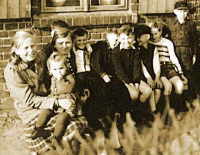 The peasants' emigration in 1952 in Ruest, led to many
discussions and reports in our village. I can remember very well, how our mothers met weekly to pluck feathers under the light of a carbide lamp. There
they discussed heavily. The peasants' emigration in 1952 in Ruest, led to many
discussions and reports in our village. I can remember very well, how our mothers met weekly to pluck feathers under the light of a carbide lamp. There
they discussed heavily.
The children in Vimfow 1952 (from left to right): Inge Garling with a daughter from L. Erdmann, next to her the "little" Inge, Günther
Pöpperl (with scarf), Richard Ridke, Manfred Moritz, Rüdiger Moritz, Willi Kolbow, standing Günther Laube.
August, 21st, 1952 Founding of the collective farm "New Life" (25 land workers and employed people,
type III)
Cattle breeding and green agriculture were being taken over to the collective company. Yard, garden and approx. 1/2 hectare of land were left for
individual use. Among the foundation members are Karl Breitmoser, Gertrud Lang, Johann Laube, Meta and Georg Seising and Luzie Werner. After 20 months,
the collective farm had 200 members.
 Newspaper
of the village 1953 ... Newspaper
of the village 1953 ...
Since 1953, the village newspaper of the MTS Mestlin is being published under the title "Workers and Peasants". In 1956 / 1957 she does not
have any title, from 1958 on the title is "The Banner". Since 1958 there is a smaller edition for the youth called "The Storm-Bird, paper
for the youth of the region of the MTS Mestlin".
In the papers, mostly current problems of the socialist build-up are being covered: ... Socialist production superior ... Competition gets us ahead ...
The biggest collective farm of our republic strikes the balance ...
1953 The MAS becomes the Machine-Tractor-Station (MTS).
Personal Report 1953
Günther Pöpperl remembers:
The housing of the school on the estate court probably didn't happen because a whole new wooden school-hut with four class rooms and two rooms for
teachers had been built between the church / the cemetary in 1953. That was a big event back then. Many students had carved the names of boys and girls,
and there was lots of excitement because of that. Each student planted a poplar in the area of the brickyard near Kadow.
 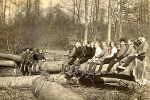 School excursion into the
forest between Mestlin and Lenschow in autumn 1953 (pictures: G. Peters). Click on the pictures for a larger scale. School excursion into the
forest between Mestlin and Lenschow in autumn 1953 (pictures: G. Peters). Click on the pictures for a larger scale.
| Around the Marx-Engels-Platz |
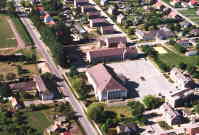 |
The new village centre
(click on the picture) |
 |
| Kulturhaus |
 |
| Schule |
 |
| Konsum |
 |
| Gemeindehaus |
1953 Redesigning of Mestlin begins
In the following years until 1962 come into being: a big cultural house, a rural hospital, a day nursery, a kindergarten, a polytechnical high school
with ten grades, a central water- and waste-water-supply, a supermarket, a rural department store for food, textiles and industrial products as well as
supermarket-restaurant with a room to rent and a state-owned restaurant and 152 municipal appartments. Mestlin had developed into a socialist sample
village.
1954 The VdGB/BHG is being dissolved.
On April 1st, 1954, the hospital is being opened.
In 1954, the supermarket and the restaurant are being opened.
In May 1954, a kindergarten (60 places) and a day nursery (45 places) are being opened.
In 1954, laying of the foundation stone of the cultural house in Mestlin. It stood under the watchwords:
"The building up of our sample village supports the development of the cultural life in rural areas and strengthens the unity of rural and urban
life"
September 16th, 1955, the Ernst-Thälmann-Street and the Marx-Engels-Place receive their names after a
decision of the local council.
1956, in January, the new food selling store and the store for household articles, and in March a store for
textile goods and shoes open.
1957, fusion of the schools of Ruest and Mestlin.
On Saturday, October 19th, 1957, the opening ceremony of the cultural house in Mestlin takes place.
Schweriner Volkszeitung on 10-21-1957
On Monday, October 21st, 1957, the Mecklenburg newspaper "Schweriner Volkszeitung", the district voice of the
Socialist Unity Party of Germany wrote:
Socialist village received cultural house: In a ceremonial event, the inhabitants of Mestlin christened their cultural house on Saturday. With that, the
eleventh and surely biggest and most beautiful rural cultural house, had been given over to the people from the biggest collective farm of our republic.
"This event is a crowning of all that, what had been done by the workers'- and peasants'-power in the past years in the former poor estate village
and current socialist village Mestlin" said comrade Franz Höppner.
The mayor of the municipality, comrade Langemer, insured, that this house will be a place of culture, a place of study.
After the big ceremony, in which the famous artists of the theatre of Schwerin and Parchim as well as the cultural orchestra from Ludwigslust and
cultural groups from Mestlin and Parchim took part, the ceremony hall was filled with dancing and playing people.
In 1958, Mestlin consists of Mestlin, Ruest-village, Ruester-Krug, Kadow, Büthberg and Vimfow with 1539
inhabitants altogether. Economical centres are the MTS (approx. 300 workers including six subsidiary offices), the collective farm "New Life"
(264 members, over 2000 hectare of land, that means it's the second biggest collective farm in the GDR) and the brickyard, in the centre are the
cultural house, the hospital, kindergarten and day nursery.
On July 12th-13th, 1958, the first district "Corn Party" is being celebrated in Mestlin. The paper
comments: "Besides a number of events on this weekend in Mestlin, besides place concerts, movie shows, outdoor dancing, besides an exhibition of
the most modern agricultural machines and tools, and besides an animal show, the celebrations of the marriage of Mr Corn and Miss carrot will be a
highlight".
On May 25th, 1959, Mestlin has 1505 inhabitants (Mestlin 988, Ruest 303, Vimfow 117).
1959, opening of the new school in Mestlin
On August 29th-30th, 1959, the second district "Corn Party" is being celebrated in Mestlin.
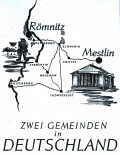 Publication: 1960
Publication: 1960
On the occasion of the 15th anniversary of the land reform, a brochure with the title "Römnitz and Mestlin - two
municipalities in Germany" was published.
The brochure describes the various developments, of the socialist Mestlin and the capitalist Römnitz after the end of the World War. The villages
have in common, that B. Berckemeyer was the mayor in Mestlin before 1945, after that he was lease-holder in Römnitz.
On March 10th, 1960, the founding of two collective farms of the type I ("Full Ear of Corn" and
"Peace") took place. Thereby, Mestlin becomes fully cooperative.
The supermarket sold in 1960: 90 TV-sets, 20 refrigerators, 18 washing machines, 11 sewing mashines, 30
Motorcycles, 43 motor bikes, 45 bikes, ...
On December 13th, 1961, parts of the ceiling in the auditorium of the cultural house loosened during a party
meeting. There were a few casualties. The suspicion of sabotage did not prove to be right.
January 1st, 1962 Mestlin only has the collective farm "New Life" of the type III.
May 1962 repeating begin of the working on the sports field in Mestlin, that originally began in March 1960,
but had been discontinued in the mean time.
1962 In Mestlin, that is including of the parts Ruest-Dorf, Ruest-Ausbau, Vimfow and Kadow, live 1620 people
altogether.
1962 opening of the gym, the school has 237 students
1962 In Mestlin, there are a village theatre, a brass band, a folk dance group, two ballroom dance groups,
two dance bands, a gymnastics group and a film- and picture circle.
1964 the RTS is being dissolved
1965 the school has 465 students
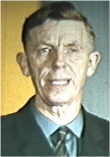 Film
1966 Film
1966
In Mestlin, a twenty-minute documentary is being filmed with the title: "On a collective farm in Mecklenburg".
It describes the village and its inhabitants: the collective farm "New Life" and the MTS, the cultural house and the school (with flag roll
call), the estate house, and the settlement houses with gardens, church and parish, new houses for rent, kindergarten, municipality house, supermarket,
...
One gets to know, that the collective farm has 50 tractors, six caterpillars and six combine harvesters. One sees the farmer Lüth in a tractor
brigade, his wife in the cattle breeding brigade, their parents on their private piece of land with their own cow, their daughter Edith in the school
(picture below right: the long year teacher and current village historican G. Peters on the school entrance).
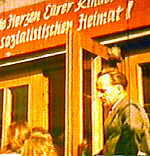 One can also see students that collect
potatoes, the collective farm chairman Karl Meiler (see picture on the right above) at the main assembly: Miss Witt and Miss Michalski apply for the
membership in the collective farm. And the red banner with white writing sais: One can also see students that collect
potatoes, the collective farm chairman Karl Meiler (see picture on the right above) at the main assembly: Miss Witt and Miss Michalski apply for the
membership in the collective farm. And the red banner with white writing sais:
Onward to new successes
in the socialist competition!
For the people -
to honor the republic!
1971? Founding of the collective farm (T) and the collective farm (P).
1972 The following part of the program of the cultural house documents the numerous circles: film group for
children, pioneer theatre, pictures, recording studio, youth dancing group, singing club, model railroad club, choir of the adults, young medics, young
talents, folk dance for children, young folk-correspondents, talented hands I, talented hands II, young philatelists.
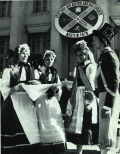 On August
29th, 1974 the municipality union Mestlin with the municipalities Mestlin, Grebbin, Herzberg, Zökow, Groß Niendorf is being founded. On August
29th, 1974 the municipality union Mestlin with the municipalities Mestlin, Grebbin, Herzberg, Zökow, Groß Niendorf is being founded.
1978 The soccer players of Mestlin ascents into the district class.
1978 All around the cultural house, there are regularly political, social and cultural events. Here it is
"The holidays of Culture and Sports - 1978" (see picture on the right - by Ernst Höhne).
1979 Unification with the school in Kladrum.
1982 The extension wing of the school is being opened, 420 students.
1983 Matthias Ortmann becomes pastor of Mestlin / Ruest
1986 the current mayor of Mestlin, Fritz Neumann, dies.
1987 celebration on the occasion of Mestlin's 675th anniversary
1987 Mestlin is being honored for being the most sportive village in the district of Schwerin.
- October 3rd, 1990
- new constitution of the land Mecklenburg-Vorpommern.
1990 The coming down of the wall, brings a number of problems for Mestlin. First plans go into the direction
of forming a service- and tourism-centre.
1993 Jens Krause becomes pastor of Mestlin / Ruest
1993 Mestlin is being connected with the natural gas network. Every house has telephone- and
cable-connections. A few private houses come into being.
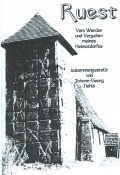 Publication: 1994 Publication: 1994
With the title "Ruest - of the becoming and ceasing of my home village", Johann - Georg Nehls (1918 - 1997)
publishes the history of his home village in a brochure with 56 pages.
Not without sadness and bitterness, the history of his family (lease-holders / owners of a farm in Ruest since 1833) until the leaving of the village in
1952 is being documented. One gets the impression that the build-up of Mestlin caused the break-down of Ruest.
1995 - 1999
Which events in Mestlin are currently in the news?
To mention are the successes of Manfred Ziebarth's soccer team "SV Grün Weiß Mestlin". Another promising thing are the activities
of the union "Mestliner Kulturhaus" e.V. (cultural house of Mestlin union). Or the christening of the newly built sewage plant in November
1998 (1.7 million D-Mark capital investment).
Further news, that have been caused by the coming down of the wall, do not sound as nice: raids on the bank in July 95 and January 99. The raid in June
99, connected with the taking of hostages, was luckily only a training. The endless story (95 - 97) with the cable TV. The Forth (Nov. 95, local
council) and Back (Jan/Feb 97, the citizens protest) over the building of a wind power station. Or the future of the school in Mestlin: in March 97 it
had been discussed with the local council, in June 98 their objective: Lower school and connected high - and junior high school
shall remain. But then, the decision of the district council in March 99: in Mestlin shall be the lower school, in Dobbertin shall stand the junior high
school.
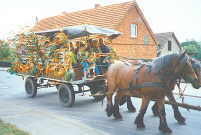 May
1997 Founding of the association "Kulturhaus Mestlin" e.V.. This association was suspended 31.12.2004. May
1997 Founding of the association "Kulturhaus Mestlin" e.V.. This association was suspended 31.12.2004.
October 1999 Thanksgiving party in Mestlin - the picture shows a colored and designed horse and cart of the
parade.
December 1999 50th anniversary of the sports union Grün Weiß Mestlin - Congratulations!
For recent information see www.mestlin.de
 |

 The peasants' emigration in 1952 in Ruest, led to many
discussions and reports in our village. I can remember very well, how our mothers met weekly to pluck feathers under the light of a carbide lamp. There
they discussed heavily.
The peasants' emigration in 1952 in Ruest, led to many
discussions and reports in our village. I can remember very well, how our mothers met weekly to pluck feathers under the light of a carbide lamp. There
they discussed heavily. 









 One can also see students that collect
potatoes, the collective farm chairman Karl Meiler (see picture on the right above) at the main assembly: Miss Witt and Miss Michalski apply for the
membership in the collective farm. And the red banner with white writing sais:
One can also see students that collect
potatoes, the collective farm chairman Karl Meiler (see picture on the right above) at the main assembly: Miss Witt and Miss Michalski apply for the
membership in the collective farm. And the red banner with white writing sais: On
On 
